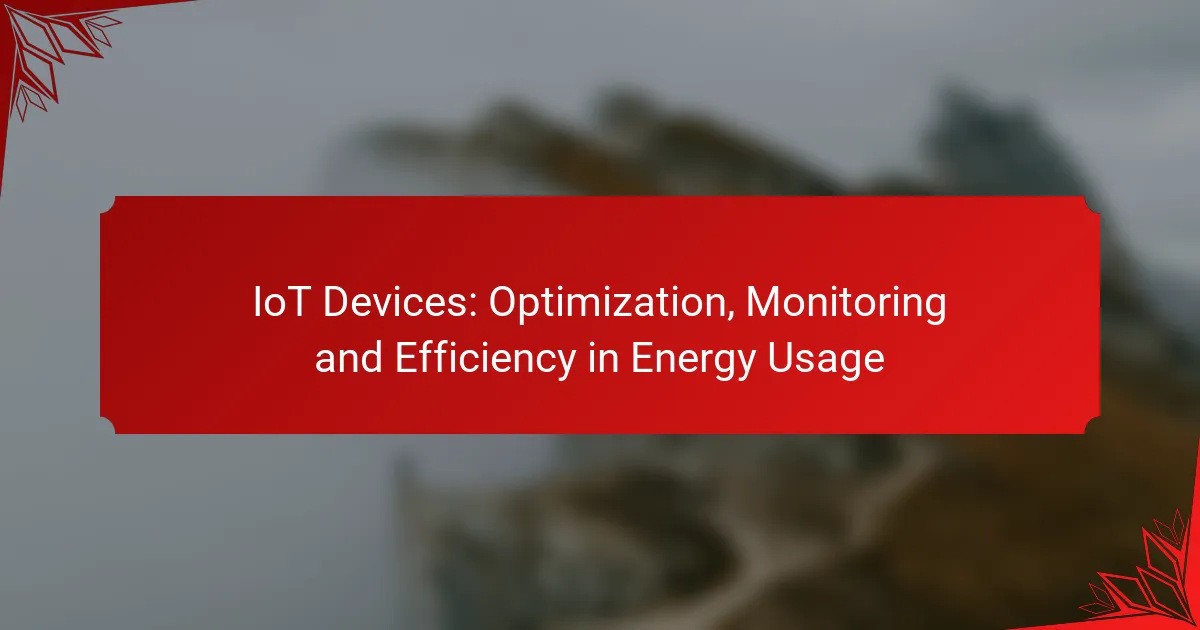Smart Grid Technology revolutionizes energy management by utilizing real-time data collection and analysis, resulting in more efficient energy distribution and consumption. By enhancing the integration of renewable energy sources, it contributes to a more reliable and sustainable energy system capable of adapting to evolving demands.
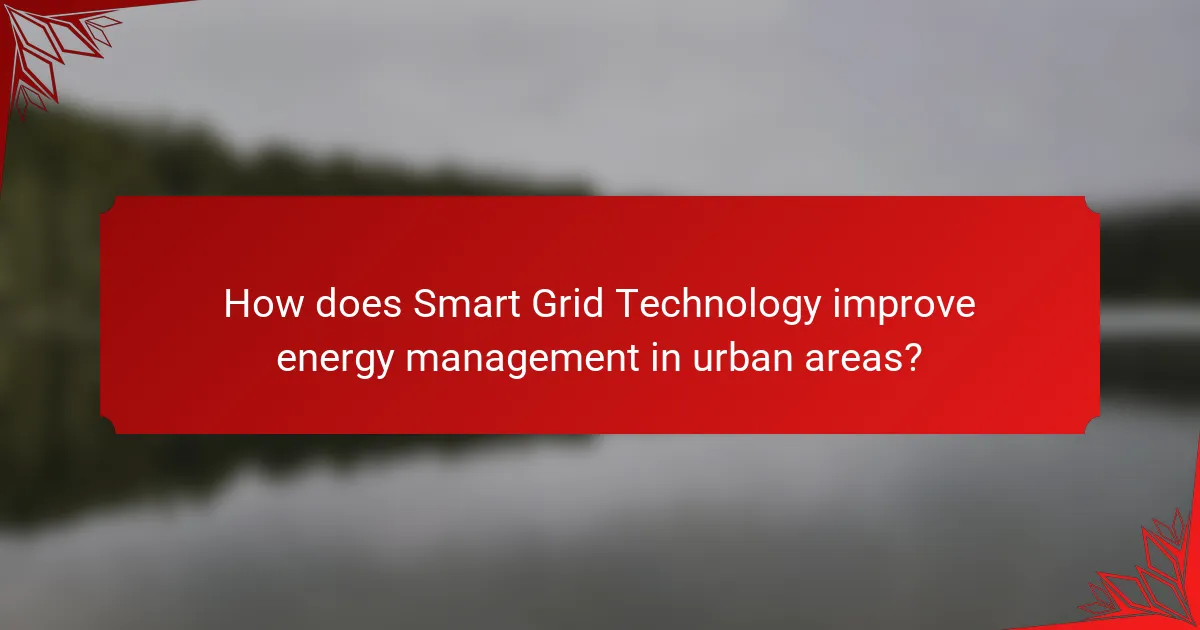
How does Smart Grid Technology improve energy management in urban areas?
Smart Grid Technology enhances energy management in urban areas by enabling real-time data collection and analysis, which leads to more efficient energy distribution and consumption. This technology allows for better integration of renewable energy sources and improves the overall reliability of the grid.
Real-time monitoring and control
Real-time monitoring and control systems are essential components of smart grids, allowing utilities to track energy usage and grid performance continuously. This capability enables immediate adjustments to energy distribution based on current demand, reducing waste and enhancing efficiency.
For instance, utilities can identify outages or inefficiencies within seconds, allowing for quicker response times and minimizing downtime. Implementing advanced sensors and communication technologies facilitates this real-time oversight.
Demand response capabilities
Demand response capabilities empower consumers to adjust their energy usage during peak periods, helping to balance supply and demand. This can be achieved through incentives or automated systems that reduce consumption during high-demand times.
For example, a utility might offer lower rates for customers who agree to reduce their usage during peak hours, effectively lowering overall energy costs and preventing grid overloads.
Integration of renewable energy sources
Smart grids facilitate the integration of renewable energy sources, such as solar and wind, into the existing energy infrastructure. This integration is crucial for reducing reliance on fossil fuels and promoting sustainability in urban areas.
By utilizing advanced forecasting and energy storage solutions, smart grids can manage the variability of renewable energy, ensuring a stable supply. Urban areas can benefit significantly from local solar installations, which can be monitored and controlled through smart grid technology.
Enhanced grid reliability
Enhanced grid reliability is a key advantage of smart grid technology, as it reduces the frequency and duration of outages. Through continuous monitoring and predictive maintenance, utilities can identify potential issues before they escalate into significant problems.
Moreover, smart grids can reroute power automatically during outages, ensuring that affected areas receive electricity from alternative sources, thus maintaining service continuity.
Reduced operational costs
Smart grid technologies can lead to reduced operational costs for utilities by optimizing energy distribution and minimizing losses. By employing data analytics and automated systems, utilities can streamline their operations and reduce the need for manual interventions.
Additionally, the implementation of smart meters allows for more accurate billing and reduces the costs associated with meter reading and maintenance. Overall, these efficiencies can translate into lower energy prices for consumers.
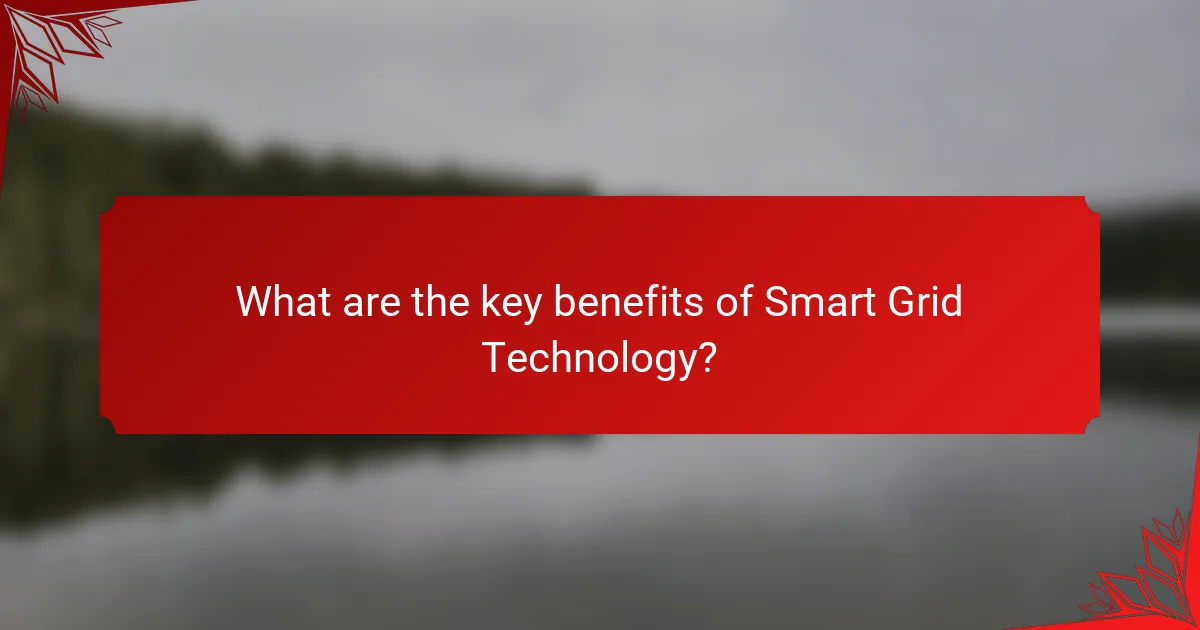
What are the key benefits of Smart Grid Technology?
Smart Grid Technology offers significant advantages, including enhanced energy management, improved efficiency, and better integration of renewable energy sources. These benefits lead to a more reliable and sustainable energy system that can adapt to changing demands.
Increased energy efficiency
Smart Grid Technology enhances energy efficiency by utilizing advanced metering infrastructure and real-time data analytics. This allows for better monitoring of energy consumption patterns, enabling utilities to optimize energy distribution and reduce waste.
For example, demand response programs can shift energy usage during peak times, helping to balance load and minimize the need for additional power generation. Households can also benefit from smart appliances that adjust their operation based on energy availability and pricing.
Lower greenhouse gas emissions
By integrating renewable energy sources like solar and wind into the grid, Smart Grid Technology contributes to lower greenhouse gas emissions. The ability to manage energy flow from these sources reduces reliance on fossil fuels, which are major contributors to climate change.
Additionally, energy efficiency improvements decrease overall energy consumption, further lowering emissions. Many regions aim for significant reductions in carbon footprints, and smart grids play a crucial role in achieving these environmental goals.
Improved consumer engagement
Smart Grid Technology fosters improved consumer engagement by providing users with detailed information about their energy usage. Smart meters allow consumers to track their consumption in real time, empowering them to make informed decisions about energy use.
Utilities can also offer personalized energy-saving tips and incentives, encouraging consumers to participate in energy conservation efforts. This engagement not only helps reduce costs for consumers but also supports grid stability.
Enhanced cybersecurity measures
As Smart Grid Technology relies on digital communication and data exchange, enhanced cybersecurity measures are essential to protect against potential threats. Utilities are implementing advanced security protocols to safeguard critical infrastructure from cyberattacks.
Regular updates, intrusion detection systems, and employee training on security practices are crucial components of a robust cybersecurity strategy. By prioritizing these measures, utilities can ensure the integrity and reliability of the smart grid, ultimately benefiting consumers and the environment alike.
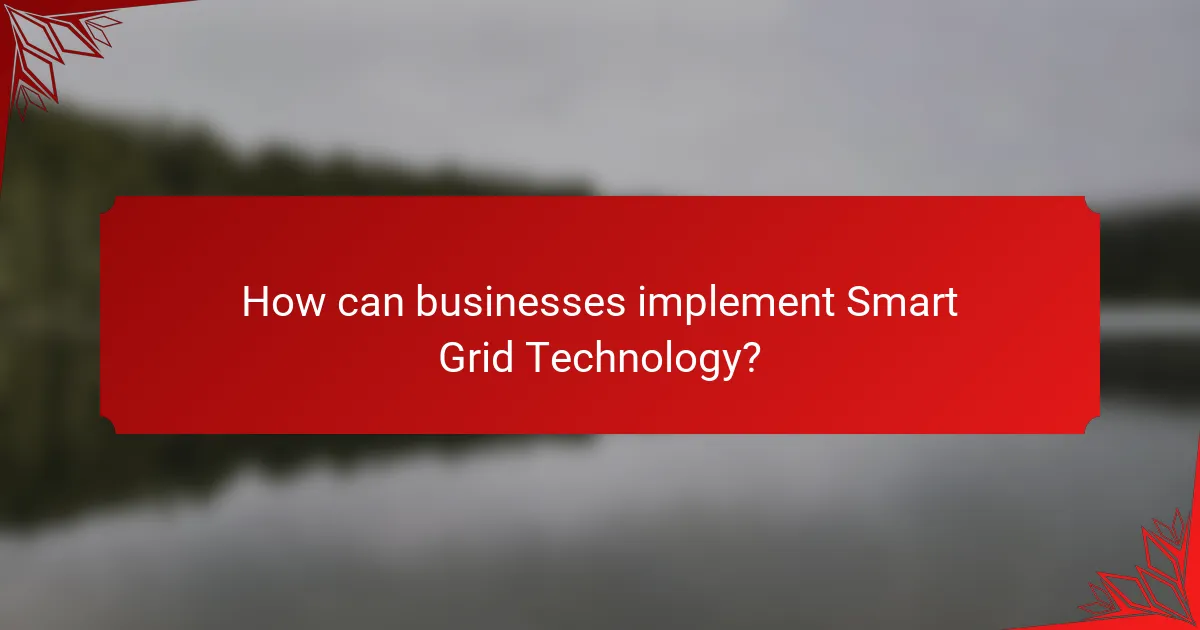
How can businesses implement Smart Grid Technology?
Businesses can implement Smart Grid Technology by focusing on strategic partnerships, investing in necessary infrastructure, and developing employee training programs. These steps enhance energy management, improve efficiency, and facilitate better integration of renewable energy sources.
Partnerships with technology providers
Forming partnerships with technology providers is crucial for businesses looking to implement Smart Grid Technology. Collaborating with established firms can provide access to advanced tools and expertise, ensuring a smoother transition to smart grid systems.
When selecting partners, consider their experience in smart grid solutions and their ability to offer ongoing support. Look for providers that align with your specific energy needs and can help integrate renewable energy sources effectively.
Investment in infrastructure upgrades
Investing in infrastructure upgrades is essential for the successful implementation of Smart Grid Technology. This may involve modernizing existing electrical grids, installing smart meters, and enhancing communication systems to facilitate real-time data exchange.
Budgeting for these upgrades typically requires significant capital, often in the range of thousands to millions of dollars, depending on the scale of the project. Prioritize upgrades that offer the best return on investment, such as those that improve energy efficiency or reduce operational costs.
Employee training programs
Developing employee training programs is vital for maximizing the benefits of Smart Grid Technology. Training ensures that staff are equipped with the necessary skills to operate and maintain new systems effectively.
Consider implementing a mix of in-house training sessions and external workshops. Focus on areas such as data analysis, system management, and customer engagement to enhance overall operational efficiency. Regularly updating training materials will help keep employees informed about the latest technologies and best practices in smart grid management.
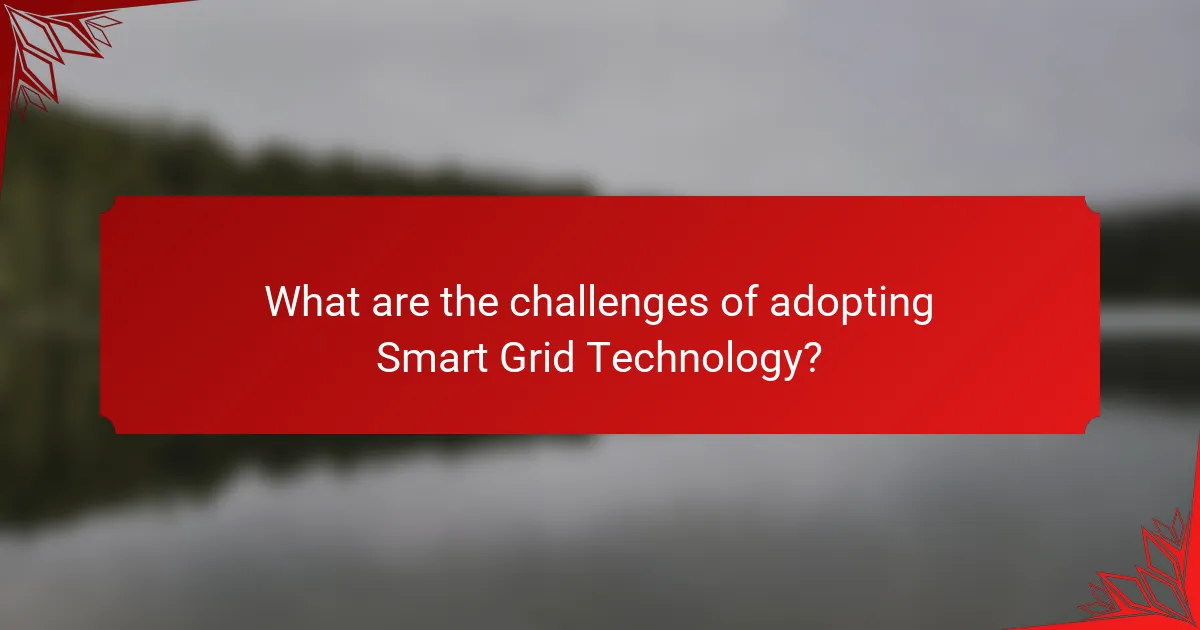
What are the challenges of adopting Smart Grid Technology?
Adopting Smart Grid Technology presents several challenges that can hinder its implementation and effectiveness. Key obstacles include high initial costs, regulatory hurdles, and data privacy concerns that utilities and consumers must navigate.
High initial costs
The transition to Smart Grid Technology often requires significant upfront investment in infrastructure, technology, and training. Utilities may face costs in the range of millions to billions of dollars, depending on the scale of the project and the existing infrastructure.
Utilities should consider phased implementation to spread costs over time and explore funding options such as government grants or public-private partnerships. This approach can help mitigate financial strain while still advancing toward a smarter grid.
Regulatory hurdles
Regulatory challenges can impede the adoption of Smart Grid Technology, as existing laws may not accommodate new technologies or business models. Utilities must navigate complex regulatory environments that vary by region, which can delay project approvals and increase costs.
Engaging with regulators early in the planning process can help identify potential roadblocks and facilitate smoother transitions. Utilities should also advocate for regulatory reforms that support innovation and investment in smart grid initiatives.
Data privacy concerns
As Smart Grid Technology relies heavily on data collection and analysis, concerns about data privacy and security arise. Consumers may worry about how their energy usage data is collected, stored, and used, leading to resistance against smart meter installations.
Utilities must prioritize transparency and implement robust data protection measures to build consumer trust. Clear communication about data usage and privacy policies, along with compliance with regulations like GDPR in Europe, can help alleviate these concerns.

What criteria should be considered when choosing Smart Grid solutions?
When selecting Smart Grid solutions, consider factors such as scalability, interoperability, cost-effectiveness, and regulatory compliance. These criteria ensure that the technology can adapt to future needs, work seamlessly with existing systems, remain within budget, and meet local regulations.
Scalability
Scalability refers to the ability of Smart Grid solutions to grow and adapt as demand increases. Look for systems that can expand their capacity without requiring a complete overhaul. For example, a modular approach allows utilities to add components as needed, making it easier to manage costs and resources.
Interoperability
Interoperability is crucial for ensuring that different Smart Grid technologies can communicate effectively. Choose solutions that adhere to established standards, such as IEC 61850 or IEEE 2030, which facilitate integration with existing infrastructure. This compatibility helps avoid vendor lock-in and allows for smoother upgrades.
Cost-effectiveness
Cost-effectiveness involves evaluating both initial investment and long-term operational costs. Assess not only the purchase price but also maintenance, training, and potential savings from improved efficiency. A solution that appears cheaper upfront may lead to higher expenses over time if it lacks durability or requires frequent updates.
Regulatory compliance
Ensure that the Smart Grid solutions comply with local regulations and standards. This may include environmental regulations, data privacy laws, and safety standards. Non-compliance can result in fines or operational delays, so it’s essential to stay informed about relevant legislation in your region.

